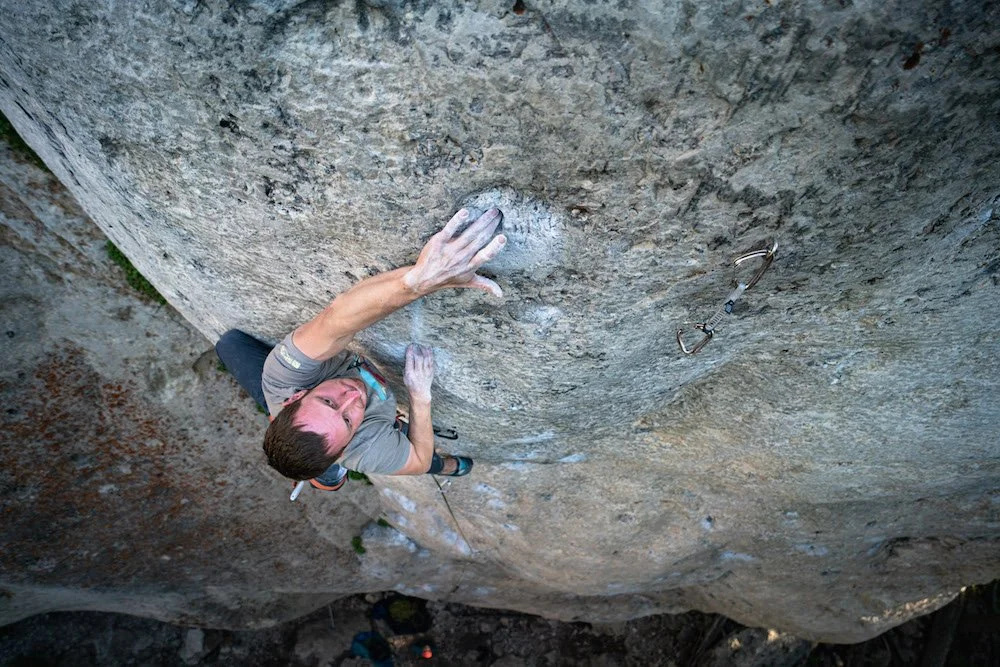Outdoor rock climbing is an exhilarating sport that combines physical strength, mental focus, and a deep connection with nature. As a beginner climber venturing into the great outdoors, it's essential to learn from the experiences of others to avoid common mistakes that can compromise safety and hinder progress. Here are some key mistakes to steer clear of as you embark on your climbing journey:
Sticking the two finger pocket while climbing in Wild Iris, WY. Photo by Dalton Johnson
1. Neglecting Proper Training and Preparation
One of the most common mistakes beginners make is underestimating the importance of proper training and preparation. Climbing outdoors presents unique challenges compared to indoor climbing, including varied terrain, weather conditions, and potential hazards. Before hitting the rocks, invest time in learning basic climbing techniques, safety protocols, and how to use essential gear like harnesses, ropes, and carabiners. Consider taking a beginner's course or hiring a certified climbing guide to ensure you start with a strong foundation.
2. Skipping Warm-Up Exercises
Warm-up exercises are crucial for preventing injuries and enhancing performance. Neglecting to warm up properly can lead to muscle strains, tendon injuries, and decreased climbing ability. Prior to each climbing session, spend at least 10-15 minutes engaging in dynamic stretches, light cardio, and specific exercises to activate key muscle groups used in climbing, such as the forearms, shoulders, and core. This preparation not only reduces the risk of injury but also improves your overall climbing experience.
3. Ignoring Safety Checks and Protocols
Safety should always be a top priority in outdoor rock climbing. Beginners often overlook safety checks and protocols, assuming that experienced climbers will take care of everything. Take responsibility for your safety by conducting thorough equipment checks before each climb, including harnesses, helmets, ropes, and anchor points. Familiarize yourself with proper belaying techniques, communication signals, and emergency procedures. Never hesitate to ask questions or seek guidance from more experienced climbers to ensure a safe and enjoyable climbing experience.
4. Overlooking Route Planning and Assessment
Selecting suitable climbing routes is essential for a successful outdoor climbing experience. Beginners sometimes make the mistake of attempting routes that exceed their skill level or underestimate the technical challenges involved. Before climbing, carefully assess route difficulty, terrain features, and potential hazards such as loose rocks or unstable surfaces. Start with beginner-friendly routes rated below your current skill level to build confidence and competence gradually. As you gain experience, you can progressively tackle more challenging climbs.
5. Failing to Communicate Effectively
Communication is key to safe and efficient climbing, especially in outdoor settings where environmental factors can impact visibility and auditory cues. Beginners may struggle with effective communication, leading to misunderstandings, misinterpretations, and potential accidents. Develop clear and concise communication protocols with your climbing partner or team, including signals for belaying, route guidance, and emergency situations. Practice active listening and maintain open communication channels throughout the climbing session to enhance teamwork and safety.
6. Rushing Through Climbs Without Rest
The excitement of outdoor climbing can tempt beginners to rush through climbs without adequate rest and recovery. Overexertion can lead to fatigue, decreased concentration, and increased risk of mistakes or accidents. Take regular breaks between climbs to rest, hydrate, and refocus your mind and body. Listen to your body's signals and avoid pushing yourself beyond your limits, especially during prolonged climbing sessions. Prioritize quality over quantity to maximize enjoyment and safety.
7. Neglecting Environmental Awareness and Leave No Trace Principles
Outdoor climbers have a responsibility to respect and preserve the natural environment. Neglecting environmental awareness and Leave No Trace principles can contribute to habitat destruction, littering, and ecosystem disturbances. Familiarize yourself with local regulations, climbing ethics, and conservation practices specific to each climbing area. Minimize your impact by staying on designated trails, properly disposing of waste, avoiding damage to vegetation, and respecting wildlife habitats. Leave the climbing area cleaner than you found it to ensure its enjoyment for future generations.
Traversing Matthes Crest in Tuolumne Meadows in Yosemite National Park. Photo by Dalton Johnson
As a beginner outdoor climber, avoiding common mistakes is essential for a safe, rewarding, and sustainable climbing experience. Prioritize proper training and preparation, follow safety checks and protocols, communicate effectively, and respect the natural environment. By learning from experienced climbers, practicing sound judgment, and continuously improving your skills, you can enjoy the thrill of outdoor rock climbing while minimizing risks and maximizing enjoyment.








